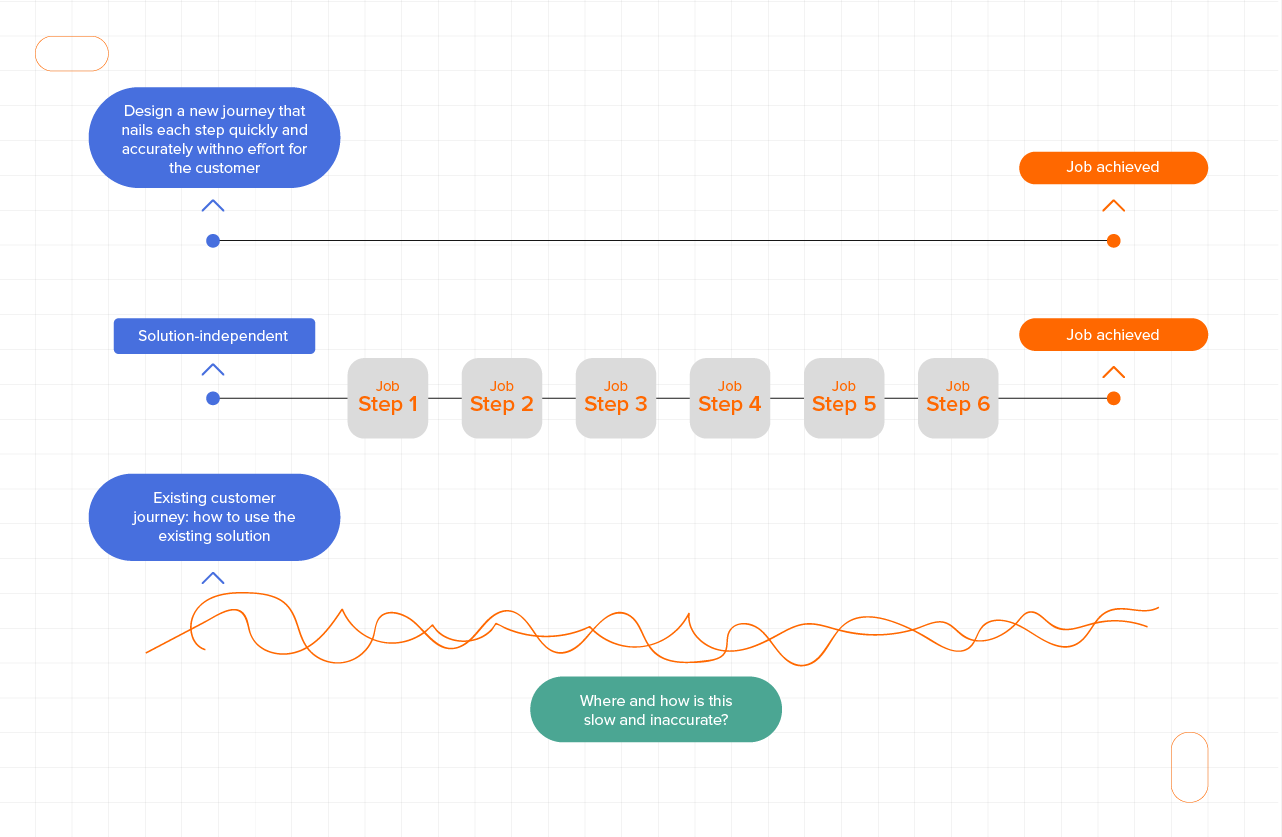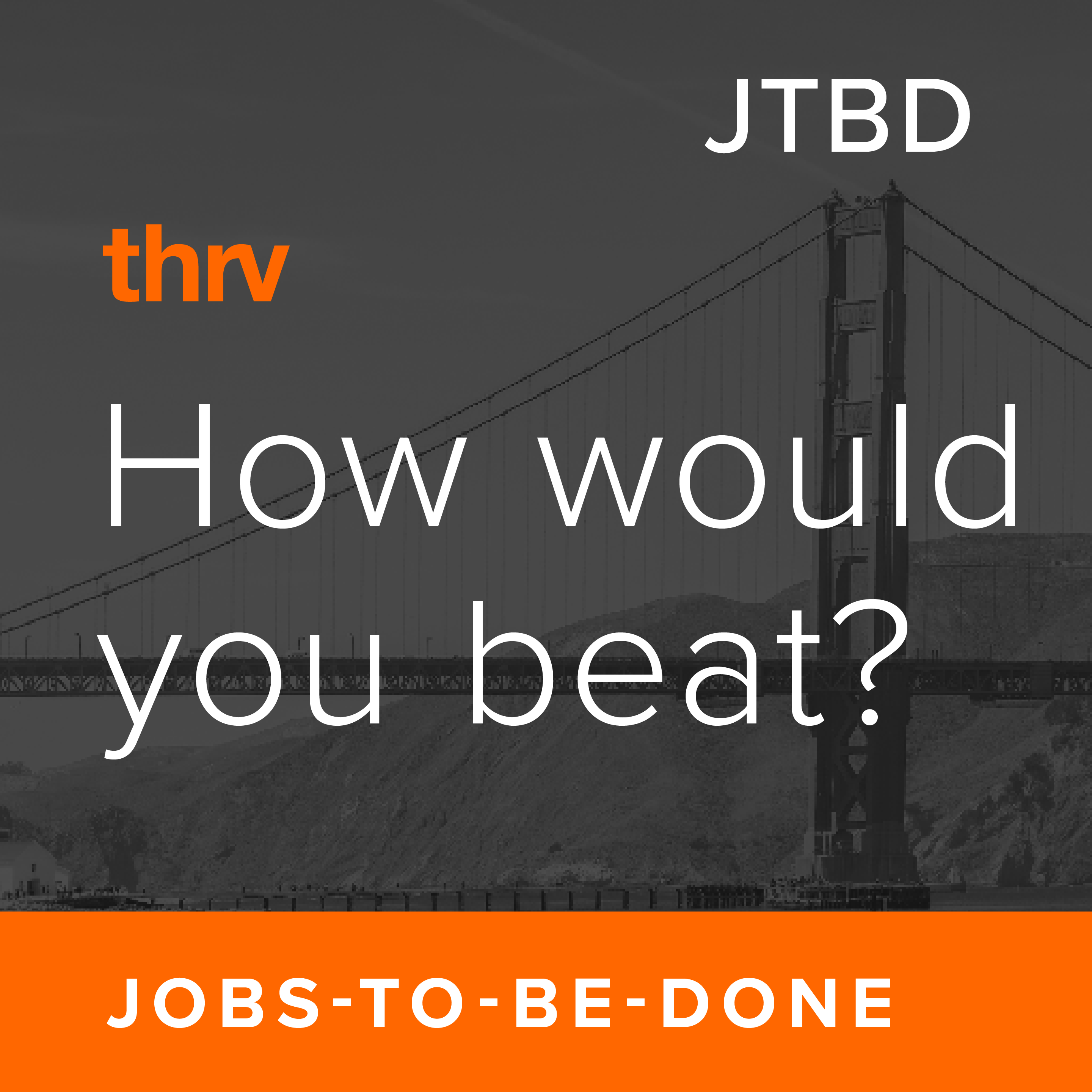September 12, 2022
How Jobs-to-be-Done Can Drive Your Customer Journey Analysis to Breakthrough Ideas
User journey is popularly defined as the process and experience that a customer goes through when using your product. Companies that are mapping user journeys using this method have taken a definitive step in the right direction towards designing a better user experience.
But, if you focus too closely on your product experience without a clear understanding of your customer’s goals, you run the risk of focusing on local optimizations and missing breakthrough ideas.
With Jobs-to-be-Done, you can enhance your user journey analysis because it expands your focus beyond local optimizations of your product to satisfying unmet needs independent of your product.
In this post, we’ll explain what it means to move beyond local optimizations, how to include JTBD in your user journeys, and how the practice impacts your company’s growth trajectory.
Understanding User Journey or Critical User Journey
We mentioned above that a user journey is typically defined as your customer’s experience using your product, broken down into steps or touchpoints that help you understand the good parts of using your product and what to improve.
You may also have heard of “Critical User Journeys.” The core of this is similar — it’s the journey a customer takes when using your product. What makes it critical? The journey ends with the user achieving their goal with your product.
Identifying the customer’s critical goal helps you ensure that the journey drives success for your user and success for your business.
But, how should your company define your customer or user’s goal?
For example, if you are a product manager or designer at Twitter, is the user goal to “compose a Tweet?” Is that critical? What if you work at Pinterest? Is the critical goal to “pin a photo?”
These examples are product-centric goals. They are about using your product. But like we said at the start, defining the culmination of a critical user journey with a product-centric goal can lead you to focus on local optimizations and miss breakthrough ideas.
Instead, by defining the goal of the critical user journey as a solution-independent job-to-be-done, your target becomes “improving someone’s life” as opposed to only making it easier to use your product. This target keeps you focused on customer value. It opens your mind to new ways of delivering customer value and helps you understand why your current user experience doesn’t deliver value to your customers. You will automatically focus your customer journey research on delivering value.
To get an idea of how product-centric goals could result in failure, let's look at Blackberry. The once-successful mobile company clearly worked on optimizing its keyboard product to make it easy to type fast on a keyboard, as if typing on a keyboard was a critical goal in a user’s life. You can see this in their marketing messages. Even in 2015, eight years after the launch of the iPhone and its success with the touch screen, Blackberry was still doing large ad buys touting their “best-in-class keyboard.” Two years later, Blackberry’s smartphone market share had dropped to 0%.
What if Blackberry had defined the goal of their user journey without mentioning any products, technologies, or features? Imagine if Blackberry had defined the job as “communicate with colleagues” or “get many jobs done on the go” (which is what you can do with the iPhone). There is a good chance that they might have looked at what technology could enable their user along their journey to the goal of “communicating with colleagues,” and they might have identified the touchscreen as a possible solution.
Instead, Apple launched the iPhone with the touchscreen while Blackberry was optimizing its keyboard.
The rest is history: Touchscreen killed the keyboard. Apple took over the market and Blackberry became a famous failure story.
Blackberry might have beaten Apple to delivering the same customer value — they already had a business device on the market, but they developed blinders while they were focusing heavily on local optimizations.
Moral of the story: You need to be aware of new technology that can help your customer achieve their jobs-to-be-done faster, more accurately, and with less effort. That’s the crux of critical user journey analysis. You want to avoid the myopia of only improving your current product at all costs.
How to use JTBD to define the goals of the critical user journey and for user journey analysis
The first thing you need to do when you want to begin mapping your user journey through the JTBD lens is to define your customer’s job-to-be-done. To do this, think about why they use your solution and then define the goal without using the product (or the product type) in the job statement.
Let’s say your company’s product is a music streaming app, and you want to conduct a user journey analysis. The first thing you will do is ask yourself: Why do customers use our product?
If you said “create a mood with music” or to “get entertained”, you’re bang on. If you had said “to stream music,” you would have been off-base because this job statement mentions a technology--streaming.
To see why this is problematic, imagine you said the goal was “to listen to MP3s.” If you’re young, you might be wondering, “What is an MP3, and why would I want to listen to one?” That’s the problem. If you think your customers want a technology, you will eventually be wrong. A new technology will replace it and make you redundant.
A solution-independent job-to-be-done stands the test of time and puts you in the driver’s seat to introduce the new technology that will get it done better. In fact, you can use this notion (does it stand the test of time?) to verify that your job statement is stable. Have people been looking to “create a mood with music” or “get entertained” forever? If so, you have a stable job-to-be-done to target.
You have succeeded at the first step of your customer journey analysis. Next, break the job down into steps.
Job steps tell the story of the milestones a customer must hit in order to get the job done well.
Ideally, a product or service hits the milestones for the customer, and the customer doesn’t have to do anything. Job Steps help us understand the complexity of a job, identify unmet needs in the job, and determine how to improve a solution to get more of the job done for customers.
In “getting entertained,” for example, the user journey might look like:
- Choose the type of entertainment (meet with friends? Watch a movie? Grab a drink?)
- Gain agreement with friends on the choice
- Get the entertainment (just click if it's a movie)
- Experience the entertainment
- Figure out if the choice is working for everyone
- Find a new entertainment option, if it’s not working out
We’re simplifying the job steps for this example of customer journey mapping, but typically there are anywhere between 8 to 18 job steps and several needs within each step.
Once the job steps are defined, you can create a customer journey mapping diagram like the one below: 
- Line 2 depicts the Job Steps or the solution-independent milestones the customer must hit on their journey to achieving the goal, the job-to-be-done.
- Line 3 represents the current user journey. In this example, we’re showing that the existing solution is error-prone and slow. The customer has to double back and repeat steps when the job goes wrong and then start afresh. It’s a messy journey. One might argue that life is messy, but your products should fix this, not reflect it.
- Line 1 is what you want the user journey to look like - smooth and clean, where customers progress towards their goal the whole time. Your solution enables your customer to get the job done quickly, without the frustration of repeating steps and dealing with errors.
Once you have charted your user journey against the steps and can understand the competitor’s journey i.e., how customers get the steps done with their product, you have the criteria for creating breakthrough ideas. Now you can constantly work towards creating a new journey that gets the steps faster, more accurately, and with less customer effort than your existing journey or your competitors.
Once we have the job steps defined, we can then choose between two approaches to improve your user journey by helping your customer achieve the critical goal (job-to-be-done) of the journey:
- Take a narrow focus for your critical use journey analysis
With this approach, the specific job step that you are focusing on becomes the goal. This is what Waze does with the job step “determine an alternative route to avoid traffic” in the job-to-be-done “get to a destination on time” job. Waze takes looks at traffic conditions on various routes to determine the route with the least traffic and other hurdles. By doing this, Waze gives customers a way to resolve one of their struggles at one of their job steps.
- Take a broad, ambitious view for your critical user journey analysis.
When you take this approach, the customer’s job-to-be-done - or end goal - becomes the goal you try to serve through your solution.
For example, going broad could look like this: The “get to a destination on time” job-to-be-done could happen in fewer job steps with Elon Musk’s idea for The Boring Company to have a car flinging tunnel. The car flinging tunnel would make traffic irrelevant and eliminate steps in the job by creating an entirely new platform for getting it done differently. It would reduce the user journey to fewer steps.
This approach can be very effective if you have a lot of capital and are willing to take on a lot of risk. It’s expensive to develop entirely new platforms for getting jobs done, but when they succeed, the results are revolutionary. (See the iPhone example above.)
Many products and companies have indeed managed to shorten and simplify the user journey to just one step, or far fewer steps. If you look at the customer job, “creating a mood with music,” there is a step where you have to obtain the music that meets the mood. When we did this with records, cassettes or CDs, we had to:
- Review the collection of music you already owned (and if you were in a car, this was either impossible or you had a big book of CDs, kicking around your car)
- Go to a store and buy a CD if you didn’t have music that fit the mood
- Put it in your player
- Select the track
- Hit play
- Repeat the process for the next song if the rest of the album has nothing that fits the mood
That’s a lot of steps. It’s slow, manual, and error-prone — what if the store was sold out of the CD you wanted, or there was a scratch on your vinyl record?
MP3s on portable players like the iPod came along and made “creating a mood with music” a lot easier. With 10,000 songs in your pocket, it was less likely you had to go to the store. But you had to use that annoying scrolly wheel to flip through 10,000 songs. You also had to use your own memory to know if they fit the mood. If you wanted something new that fit the mood, you were out of luck.
Today with streaming technology, nearly every song ever recorded is in your pocket. Apps like Spotify and Pandora recommend songs you’ve never known that fit the mood, and in a very small number of clicks, you’ve gotten the job done.
Tower Records and Newbury Comics spent countless hours and investment optimizing their store experiences, and now they don’t exist. If you focus only on your product and the experience of using your product in your customer journey research, you risk missing new ways to get the job done beyond your current product and losing everything to new competitors.
This is why it’s so important to have a customer goal that’s independent of your product at the culmination of your user journey mapping and analysis.
Customer value emerges from helping them achieve their real-life goal faster and more accurately than how they try to do it today.
The thrv software automates the process of zeroing on that goal by breaking down a customer’s job steps so that you can identify the needs at each job step. An inbuilt survey tool makes customer journey research much easier by helping you to determine and verify unmet needs.
You can use the thrv software on your own or engage thrv to join your team and partner with you to execute the work. To learn more about identifying your customers’ job-to-be-done, breaking the job down into job steps, and prioritizing your roadmap to track unmet needs, contact thrv today.
Posted by Jared Ranere View all Posts by Jared Ranere





